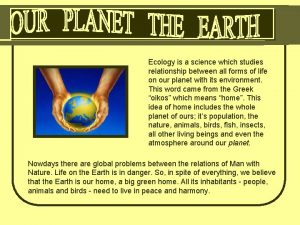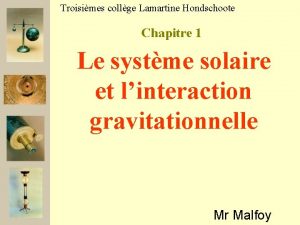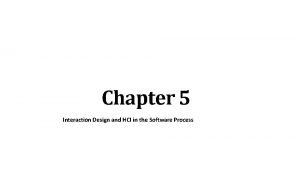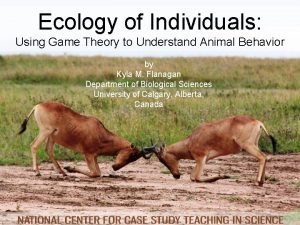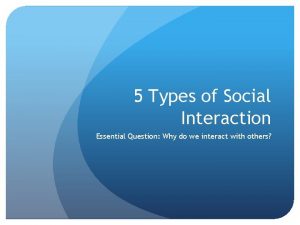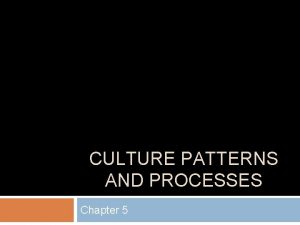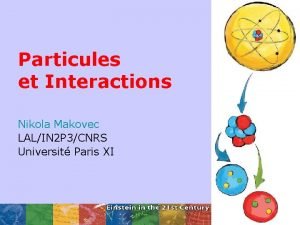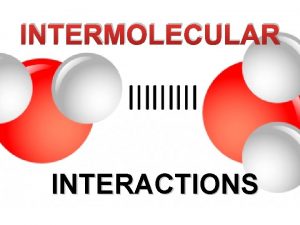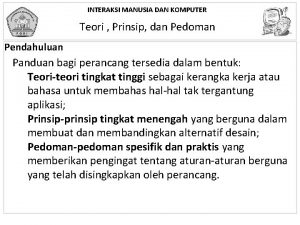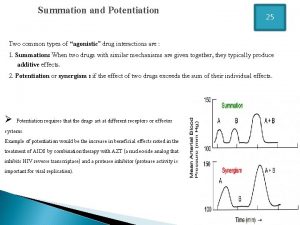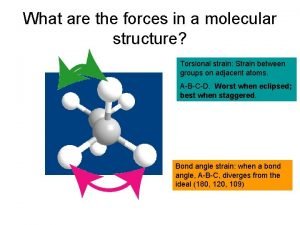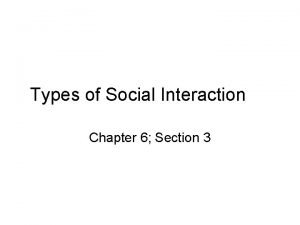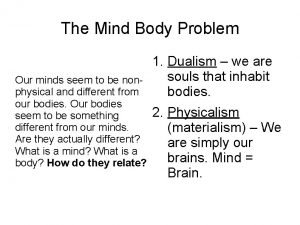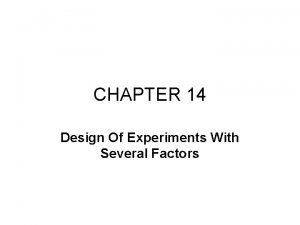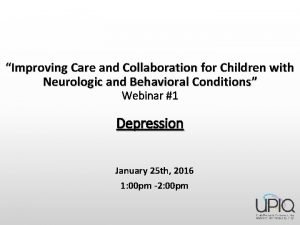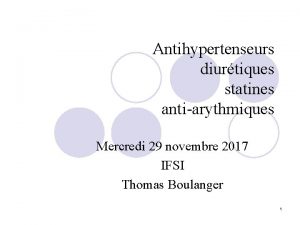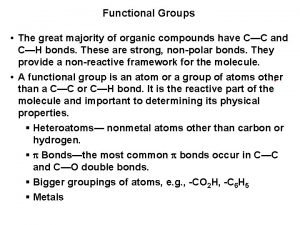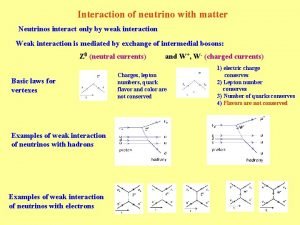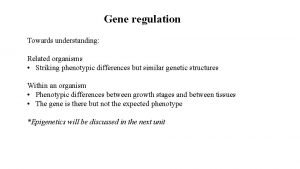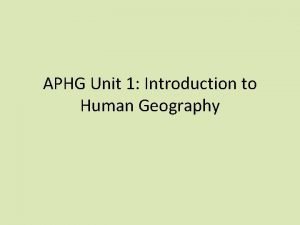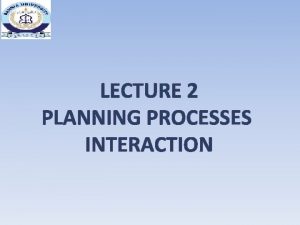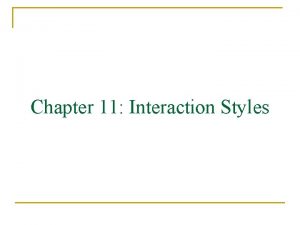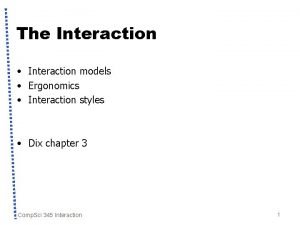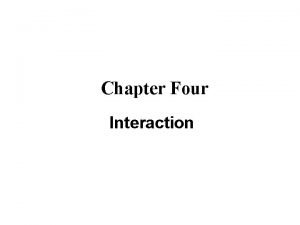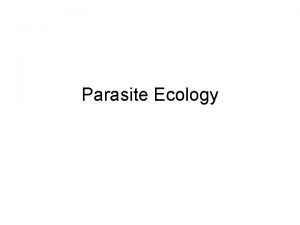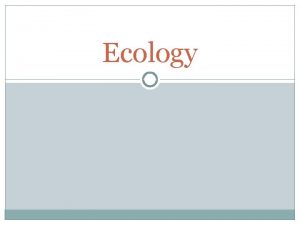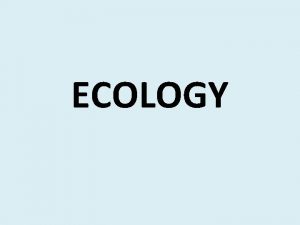Ecology What is ecology Ecology studies the interaction






























































































- Slides: 94

Ecology

What is ecology? • Ecology studies the interaction between organisms and their environment. • Biotic Factors: living organisms. • Abiotic Factors: non-living factors such as weather, climate, etc.

Levels of Organization • • • Organism - individual Population – members of the same species Community – 2 or more populations Ecosystem – communities & abiotic factors Biome – ecosystems with similar climates Biosphere – entire planet (largest level)


Organisms and their environment are interdependent. The largest level of organization is The Biosphere, which contains the combined portions of the planet in which all of life exists, including land, water, and air.

The biosphere contains multiple Biomes, which are groups of ecosystems that have the same climate. Biomes contain populations which are collections of all the organisms that live in a particular place and their physical environment.

A species is a group of organisms so similar to one another that they can breed and produce fertile offspring. Groups of species are called populations, which are groups of the same species that live in a certain area.

Groups of populations make a community when they include several different types of populations living together.

You Are Done With Notes For Today

Interdependence • Interactions within the biosphere produce a web of interdependence between organisms and the environment in which they live. These interactions begin with the need for energy to power life’s processes. The flow of energy through an ecosystem is one of the most important factors that determines the system’s capacity to sustain life.

Organism Roles • Sunlight is the main energy source for life on Earth. • Producers (autotrophs) are organisms that make their own food. • Consumers (heterotrophs) cannot harness energy directly from the environment, so they rely on other organisms for their energy.

Organism Roles • Carnivores eat only animals. Ex: hawk, lion • Herbivores eat only plants. Ex: deer, cow, grasshopper • Omnivores eat both plants and animals. Ex: human • Scavengers eat dead animals only. Ex: vulture • Decomposers break down organic matter. • Ex: bacteria, fungi

Energy Flow • Energy flows through an ecosystem in one direction, from the sun to autotrophs, then to heterotrophs. The relationships between producers and consumers connect organisms into feeding networks based on who eats whom.

Energy Flow • The energy stored by producers can be passed through an ecosystem along a food chain, a series of steps in which organisms transfer energy by eating and being eaten. • Remember, the arrow points to where the energy is going (who is doing the eating!)

Energy Flow • Food web - A diagram showing all the feeding relationships between organisms of a community (all the food chains in one area combined).

Energy in the Ecosystem • Transfer of energy from the prey to predator is not complete – only 10% of the energy in prey is usable. Therefore, if you draw a picture of energy in an ecosystem, you get a pyramid. • The most energy in an ecosystem is contained in the producers at the bottom. The least amount of energy is contained in the consumers level at the top. • **Decomposers are found at every level of the energy pyramid.

Energy in the Ecosystem • It takes a lot of producers to support one primary consumer because they only get 10% of the energy!

Pyramids of ______________ measure the amount of mass of organisms in an ecosystem and are drawn the same way.

Organism Relationships • Predator – An organism that feeds on another (ex: a frog is a predator of the fly • Prey – The organism being eaten (ex: rabbit is prey of hawk) • Note: In an ecosystem, the number of predators and prey are constantly changing due to changes in the populations. • This is called dynamic equilibrium, because overall the numbers remain the same but they shift slightly as they move above and below the equilibrium line.

Organism Relationships At First : More grass = more rabbits More rabbits = more foxes Over Time: More foxes = less rabbits Less rabbits = less foxes And the cycle starts over again!

Carrying Capacity • The carrying capacity is the number of organisms that can be supported in an ecosystem that is balanced.

Symbiosis • Symbiotic relationships (Symbiosis) - relationships between 2 organisms living together • Mutualism – each organism gives the other something they need. • ex: Clown fish (Nemo) & sea anemone. Fish gets a place to live and food, anemone is protected and cleaned by fish.

Symbiosis Commensalism – one organism gives the other something it needs, the other is unaffected. ex: Eyelash mites and humans. These microscopic organisms live in your pores and hair follicles, usually on the nose, forehead, cheek, and chin, and often in the roots of your eyelashes. Mites feed on dead skin cells, but do not harm their host (humans).

Symbiosis • Parasitism – the host organism gives the parasite something it needs, the parasite benefits while the host is harmed or killed by the parasite. • ex: Human & tapeworm. The tapeworm gets food from the Human. The tapeworm benefits from the food, but the human is harmed by lack of food.

Factors Affecting Ecosystems • Ecosystems are dynamic • Change occurs constantly in response to stresses and pressures • Living and non-living factors can impact ecosystems

Matter Cycles • Ecosystems need energy, but they also need water, minerals, and other life-sustaining compounds. • Unlike the one-way flow of energy, matter is recycled. Matter can cycle through the biosphere because biological systems do not use up matter, they transform it into living tissue or pass it out of the body as waste products (including heat).

The Water Cycle

The Nitrogen Cycle

The Carbon Cycle

Climate • Climate refers to the average, year-after-year conditions of temperature and precipitation in a particular region. • Our climate is changing due to human activities such as manufacturing, transportation and mining. • Global warming is causing more intense weather patterns such as hurricanes, tsunamis, flooding and droughts.


The Greenhouse Effect • Certain gases in our atmosphere trap heat energy from the sun and maintain Earth’s temperature range, similar to the glass windows of a greenhouse. • The natural situation in which heat is retained by this layer of greenhouse gases is called the greenhouse effect.


Limiting Factors • A limiting factor is anything that will limit the growth of a population. There are six main limiting factors: • Amount of food and water available • Amount of competition for limited resources • Amount of light available (plants) • Number of predators • Disease • Amount of shelter available

Animal Limiting Factors Animals compete with each other for resources: • -food • -water • -habitats (shelter) • -breeding partners

Plant Limiting Factors • • • Plants compete with each other for resources: -sunlight -habitats (space to grow) -pollinators -water -nutrients and minerals

Interdependence • Remember that if one of these resources increases or decreases, all the organisms in the food web will be affected. • The more biodiversity an ecosystem has, the better chance it has of avoiding collapse

Niches • These resources together make up an organism’s niche. This describes an organism’s role in the environment, and includes the type of food it eats, how it obtains this food, and which other species use the organism as food.

Warbler Niches • Species can occupy the same habitat if they have a different niche

Biodiversity • Biodiversity is the number of different species of living things in an area. • Biodiversity is one of Earth’s greatest natural resources because species of many kinds have provided us with foods, industrial products, and medicines. • ex: the rosy periwinkle plant is the source of substances used to treat certain cancers.

Biodiversity • The biodiversity represented by wild plants and animals is a kind of “library” of genetic information upon which humans can draw for future use.

Ecosystem Stability • • • Areas with high biodiversity are more stable because: There are more types of shelter There are more food options for all the predators (If one plant dies out, there will be others to feed on) There is usually more water

Ecosystem Stability • • Areas with low biodiversity are less stable because: There is less shelter There are less food options There is usually less water

Desert Forest ____ Biodiversity Tropical Rain _____ Biodiversity


Succession Ecological succession – the changing of one ecosystem to another over time. Ecological succession can occur due to: • human activities • natural events (floods, fires, volcanic eruptions)

Succession • Ecosystems will usually recover, but it takes a very long time. Succession will occur until a climax community is reached. • A climax community is the most stable community that can exist in an area.

Succession • The first organisms to occupy an area are called pioneer organisms. Each new organism changes the area and makes it better for new organisms.

Succession Crustose lichens are pioneer organisms because they can grow on rocks where plants can’t. They release a chemical that slowly breaks down rocks and releases minerals, which eventually forms a thin layer of soil.

Succession

Succession Note: The types of plants will determine the types of animals in an ecosystem. ex) If mainly grasses are present, that will limit the types of animals to small, land animals. Birds will have no trees to live in.

Succession Remember: More organisms = More Biodiversity = More Stability

Human Impact & Biodiversity • Another word for differences is diversity. • Biological diversity (or biodiversity) is the total of the different types of organisms in the biosphere. • Ecosystem diversity is the variety of habitats, communities, and ecological processes in the living world. • Species diversity is the number of different species in the biosphere. So far, biologists have identified and named about 1. 5 million species and estimate that millions more may be discovered in the future. • Genetic diversity is the total of all the different forms of genes carried by all organisms living on Earth today.

The Value of Biodiversity is one of the Earth’s greatest natural resources. Species of many kinds have provided us with: • Foods • industrial products • medicines – including painkillers, antibiotics, heart drugs, antidepressants, and anticancer drugs. When biodiversity is lost, potential sources of material with significant value to the biosphere and to humankind may be lost with it.

Threats to Biodiversity • Human activity can reduce biodiversity by causing various species to become endangered or extinct.

Threats to Biodiversity • Habitat destruction – when land is developed, natural habitats may be destroyed. Habitats supply organisms’ needs, and they are a limited resource. Species’ longterm survival depends on the preservation of their habits.

Threats to Biodiversity • Overhunting – when humans hunt animal species for food or other products such as fur, horns or hides until the species becomes endangered or extinct. Example: Elephant tusks

Threats to Biodiversity • Pollution – many toxic chemicals are introduced daily into the biosphere, but one of the most serious problems occurs when they accumulate in the tissues of organisms, a process called biological magnification. Example: The pesticide DDT in the 1930 s

Bio-magnification

Bio-magnification • DDT is a persistent organic pollutant, meaning it does not break down in the environment. • Despite a ban on their production in the 1970 s, PCBs still persist in the environment. Much of the Great Lakes area is still heavily polluted with PCBs, despite extensive clean-up work. Locally caught fresh water fish and shellfish are contaminated with PCBs and their consumption is restricted.

Bio-magnification • In the mid-60’s PCBs were so widespread that they were even found in human breast milk.

Invasive Species Foreign species – when humans transport plants and animals around the world (either accidentally or intentionally), these often become invasive species. Species that do not belong in an ecosystem will reproduce rapidly because their new habitats lack natural parasites and predators that control the population in their natural habitats.

Invasive Species Example: zebra mussels in the Great Lakes were imported from Europe in the 1980 s by attaching to ships

Conserving Biodiversity

Conserving Biodiversity In order to preserve biodiversity, we need to use conservation methods. This includes using wise management of natural resources, including preservation of habitats and wildlife. Making educated responsible decisions requires weighing costs and benefits of decisions that affect society and nature.

Conserving Biodiversity Some strategies include: • natural parks to preserve ecosystems • game reserves to control hunting • passing well-researched governmental regulations that balance costs and benefits • public awareness through informative events such as Earth Day, first celebrated in 1970 in New York State

Conserving Biodiversity • focusing conservation efforts on biodiversity hot spots, which areas identified as having high levels of biodiversity such as the Amazon rainforest

Larger Scale Threats Global warming – an increase in the average temperature of the biosphere. This is believed to be due in part to human activities, which release carbon dioxide and other greenhouse gases (gases which collect and prevent the sun’s heat from escaping the atmosphere, causing the Earth to act as a giant greenhouse).

Global Warming Carbon emissions come from burning fossil fuels (coal, oil, and natural gas). Common sources of carbon dioxide include industrial factories and car exhaust.

Climate Change • Increasing global temperatures causes changes in weather patterns, such as stronger hurricanes, droughts and flooding, El Nino, and tsunamis. • Warmer temperatures are melting the polar ice caps, causing rising sea levels. Many coastal cities may soon be underwater.

Ozone Layer Ozone Depletion – The ozone layer is a portion of the Earth’s atmosphere that contains ozone molecules (three oxygen atoms, or O 3). This layer acts as a global sunscreen, shielding the biosphere from radiation from sunlight, called ultraviolet (UV) radiation, which causes not only sunburns but skin cancer, eye damage, and decreased resistance to disease, as well as plant tissue damage.

Ozone Layer In the 1970 s scientists discovered that the ozone layer has holes, which have since grown larger. The largest is positioned over Antarctica, and a similar hole has also appeared over the Arctic.

Ozone Layer The cause is believed to be chlorofluorocarbons, or CFCs, which bind with the ozone molecules. These chemicals, often used in refrigerants and aerosols, were banned in 1987, and the holes are predicted to disappear within 50 years.

Pollution • Pollutants are harmful materials that can enter the biosphere through the land, air, or water. The major types of pollution are: 1. Air pollution 2. Water pollution 3. Land pollution

Air Pollution Air pollution – Release of chemicals and particulates into the atmosphere. Usually caused by factory emissions, this can cause smog: a mixture of chemicals that creates a gray -brown haze in the air, causing respiratory problems such as asthma.

Air Pollution Industrialization is one of the leading causes of pollution worldwide; in the United States, for example, the Environmental Protective Agency estimates that up to 50% of the nation's pollution is caused by industry. Industrial pollution is a serious problem for the entire planet, especially in nations which are rapidly industrializing, like China.

Air Pollution Acid rain occurs when factors release chemicals such as nitrogen and sulfur into the atmosphere, which then combine with water vapor in the air and fall with rain. This toxic rain kills plants and changes the chemistry of soil by releasing toxins such as mercury.

Air Pollution The Adirondack Mountains in upstate New York have suffered the worst damage in the nation from acid rain. Now, more than 500 lakes and ponds (out of 2, 800) in the Adirondack Park are already too acidic to support the plants and aquatic wildlife that once existed in them.

Air Pollution

Water Pollution Water pollution - caused by the release of waste products and contaminants

Water Pollution Water pollution can occur when toxins directly enter water directly through several ways: • Liquid spills • Sewer discharges • Littering and dumping • Thermal pollution

Water Pollution Water pollution can also occur indirectly, through surface runoff.

Eutrophication occurs when excessive nutrients cause algae blooms. This cuts off oxygen from organisms living in the water.

Soil Pollution • Comes from chemicals, solid wastes, and pesticides leaking into the ground.

Biological Controls Biological controls should be used whenever possible. A biological control is the control of pests by disrupting their ecological status through the use of organisms that are natural predators, parasites, or pathogens, rather than through harsh chemicals.

Use of Non-Renewable Resources Nonrenewable Resources – are environmental goods and services that cannot be replenished by natural processes. Examples of nonrenewable resources include: • -fossil fuels such as coal, oil, and natural gas. Fossil fuels are formed over hundreds of millions of years from deeply buried organic materials, so when they are depleted, they are gone forever.

Renewable Resources Renewable resources should be used whenever possible. Examples of renewable resources include: • -air • -fisheries • -fresh water • -land & soil • -forests & trees

Threats to Natural Resources Many human activities are threatening the Earth’s natural resources: soil erosion – the wearing away of surface soil by water and wind (runoff)

Threats to Resources desertification – when ecosystems are pushed backwards through the succession process due to farming, overgrazing, and drought until they become deserts

Threats to Resources deforestation – loss of forests which can lead to severe soil erosion, depletion of nutrients, food, oxygen, and habitats, loss of biodiversity, and eventual carbon dioxide poisoning

Threats to Resources overfishing & overhunting – when animals are killed faster than they can reproduce, the populations quickly decline and risk extinction

Human Overpopulation • The single largest threat to the health of the Earth is the human population. • As of May 2009, the Earth's population is estimated to be about 6. 77 billion. The world population has been growing continuously since the end of the Black Death around 1400.

Human Overpopulation • According to population projections, world population will continue to grow until around 2050. • World births have leveled off at about 137 -million-peryear, since their peak at 163 -million in the late 1990 s, and are expected to remain constant. • However, deaths are only around 56 million per year. Since births outnumber deaths, the world's population is expected to reach about 9 billion by the year 2040.

You are done with notes today.
 Paradigm shift from women studies to gender studies
Paradigm shift from women studies to gender studies Ecology is a science which studies the relationship between
Ecology is a science which studies the relationship between Sự nuôi và dạy con của hươu
Sự nuôi và dạy con của hươu Các châu lục và đại dương trên thế giới
Các châu lục và đại dương trên thế giới Dot
Dot Nguyên nhân của sự mỏi cơ sinh 8
Nguyên nhân của sự mỏi cơ sinh 8 Bổ thể
Bổ thể Phản ứng thế ankan
Phản ứng thế ankan Thiếu nhi thế giới liên hoan
Thiếu nhi thế giới liên hoan Hát lên người ơi
Hát lên người ơi điện thế nghỉ
điện thế nghỉ Fecboak
Fecboak Một số thể thơ truyền thống
Một số thể thơ truyền thống Sơ đồ cơ thể người
Sơ đồ cơ thể người Cong thức tính động năng
Cong thức tính động năng Số nguyên tố là
Số nguyên tố là đặc điểm cơ thể của người tối cổ
đặc điểm cơ thể của người tối cổ Tỉ lệ cơ thể trẻ em
Tỉ lệ cơ thể trẻ em Các châu lục và đại dương trên thế giới
Các châu lục và đại dương trên thế giới ưu thế lai là gì
ưu thế lai là gì Thẻ vin
Thẻ vin Kể tên các môn thể thao
Kể tên các môn thể thao Tư thế ngồi viết
Tư thế ngồi viết Bàn tay mà dây bẩn
Bàn tay mà dây bẩn Hình ảnh bộ gõ cơ thể búng tay
Hình ảnh bộ gõ cơ thể búng tay Từ ngữ thể hiện lòng nhân hậu
Từ ngữ thể hiện lòng nhân hậu Trời xanh đây là của chúng ta thể thơ
Trời xanh đây là của chúng ta thể thơ Tư thế ngồi viết
Tư thế ngồi viết Thế nào là giọng cùng tên?
Thế nào là giọng cùng tên? Chó sói
Chó sói Thể thơ truyền thống
Thể thơ truyền thống Hổ đẻ mỗi lứa mấy con
Hổ đẻ mỗi lứa mấy con đại từ thay thế
đại từ thay thế Thế nào là hệ số cao nhất
Thế nào là hệ số cao nhất Diễn thế sinh thái là
Diễn thế sinh thái là Vẽ hình chiếu vuông góc của vật thể sau
Vẽ hình chiếu vuông góc của vật thể sau Frameset trong html5
Frameset trong html5 Làm thế nào để 102-1=99
Làm thế nào để 102-1=99 Thế nào là mạng điện lắp đặt kiểu nổi
Thế nào là mạng điện lắp đặt kiểu nổi Mật thư anh em như thể tay chân
Mật thư anh em như thể tay chân Lời thề hippocrates
Lời thề hippocrates Glasgow thang điểm
Glasgow thang điểm Vẽ hình chiếu đứng bằng cạnh của vật thể
Vẽ hình chiếu đứng bằng cạnh của vật thể Quá trình desamine hóa có thể tạo ra
Quá trình desamine hóa có thể tạo ra Diagramme objet interaction
Diagramme objet interaction Hci in software process
Hci in software process Areas of the screen that behave as if they were independent
Areas of the screen that behave as if they were independent Palin parent child interaction
Palin parent child interaction Total physical interaction
Total physical interaction How do these screen objects afford?
How do these screen objects afford? Ion dipole intermolecular forces
Ion dipole intermolecular forces Dove
Dove Secondary group
Secondary group 5 types of social interaction
5 types of social interaction Relocation diffusion def
Relocation diffusion def It interaction model
It interaction model Interaction faible
Interaction faible Square well potential
Square well potential Emotional interaction in hci
Emotional interaction in hci Four basic activities of interaction design
Four basic activities of interaction design Geography diffusion
Geography diffusion Interaction design lifecycle model
Interaction design lifecycle model Prinsip interaksi manusia dan komputer
Prinsip interaksi manusia dan komputer World history patterns of interaction
World history patterns of interaction Summation drug interaction
Summation drug interaction Customer interaction management
Customer interaction management The geographic study of the distribution of languages
The geographic study of the distribution of languages Jelaskan tentang antarmuka generasi masa depan
Jelaskan tentang antarmuka generasi masa depan The symbiotic relationship between
The symbiotic relationship between Physical interaction design
Physical interaction design Definition of human computer interaction
Definition of human computer interaction What is a gauche interaction
What is a gauche interaction What is social interaction
What is social interaction User system interaction
User system interaction Software engineering
Software engineering What is problem space in hci
What is problem space in hci Who is this
Who is this Avaya vs customer interaction center cic
Avaya vs customer interaction center cic History of human computer interaction
History of human computer interaction Weak interaction
Weak interaction World history patterns of interaction
World history patterns of interaction Main and interaction effects
Main and interaction effects Simple interaction design lifecycle model
Simple interaction design lifecycle model Ssri drug interaction chart
Ssri drug interaction chart Interaction diagram vs sequence diagram
Interaction diagram vs sequence diagram Interaction médicamenteuse bêta-bloquant
Interaction médicamenteuse bêta-bloquant Intermolecular forces of functional groups
Intermolecular forces of functional groups Interaction dm
Interaction dm World history patterns of interaction solutions
World history patterns of interaction solutions Neutrino interaction with matter
Neutrino interaction with matter Interaction
Interaction Mendelian slicer
Mendelian slicer Perceptual region definition
Perceptual region definition Stanford hci group
Stanford hci group Project management process interactions
Project management process interactions

